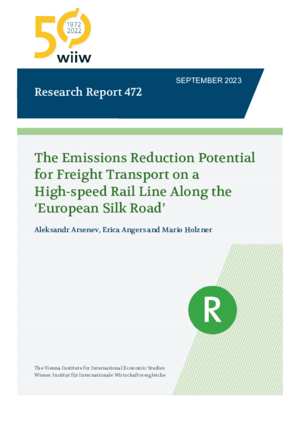The Emissions Reduction Potential for Freight Transport on a High-speed Rail Line Along the ‘European Silk Road’
Erica Angers, Aleksandr Arsenev and Mario Holzner
wiiw Research Report No. 472, September 2023
25 pages including 2 Tables and 3 Figures
This report estimates the CO2 emissions of freight transport on a hypothetical high-speed rail (HSR) line along the northern route, from Lyon to Warsaw, of a ‘European Silk Road’ (ESR). Using a methodology consisting of predictions regarding the freight-carrying capacity of the future HSR, and the commodity-level switchover, our results indicate that a best-case scenario, at a project lifecycle of 60 years, in which all trains run with 257 tonnes of load, provides for a reduction of 176.2 Mt of net CO2 emissions compared with current levels. These lifespan savings are comparable to a reduction of net emissions by close to 24% of the overall EU transport sector emissions (excluding air transport) of one year (as measured by the net emissions in 2018). The net negative emissions in the optimistic full-capacity scenario will compensate for the construction costs in 13 years. Thus, the potential for emission reduction along the northern route of the ESR is quite substantial, given that this is just one line, with limited capacity. This hints at the importance that bold missions, such as the construction of a pan-European HSR network, could have for the definition of a European Green Industrial Policy that is capable of supporting the fulfilment of the goals of the Paris Agreement on climate change.
Keywords: Climate change, ecological efficiency, European Silk Road, European Union, green growth, green transition, high-speed rail (HSR), infrastructure, intermodal competition, life-cycle analysis (LCA), logistics, modal shift, train networks, transportation
JEL classification: H54, L91, L92, Q42, Q50, Q51, Q55, Q56, Q58, R40, R41, R42
Countries covered: European Union
Research Areas: Sectoral studies
